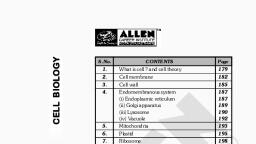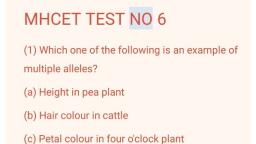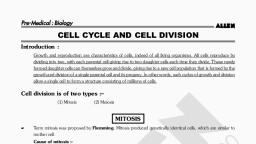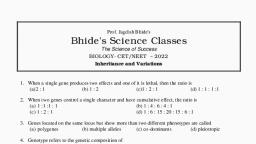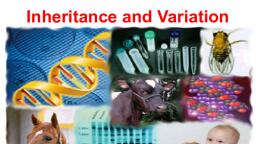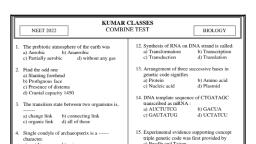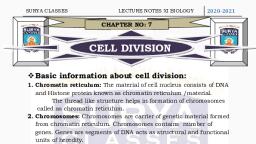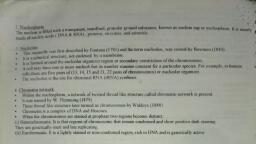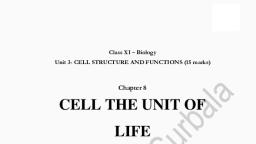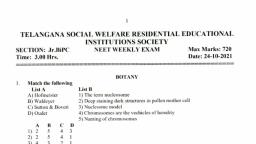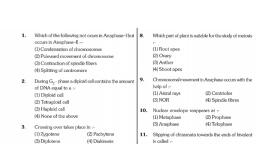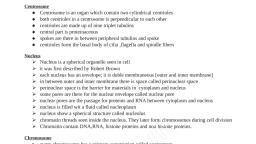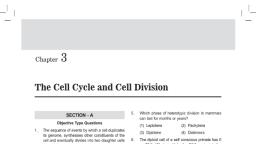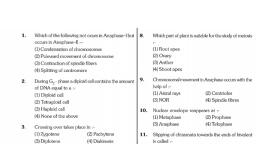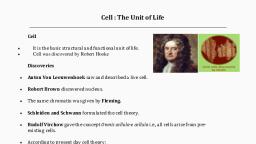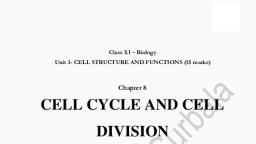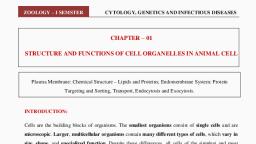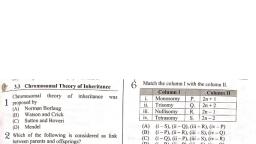Page 1 :
Chromosome, •, •, •, •, , In the nucleus of each cell, the DNA molecule is packaged into thread-like structures called, chromosomes., Each chromosome is made up of DNA tightly coiled many times around proteins called histones that, support its structure., Chromosomes were first described by Strasburger (1815), and the term ‘chromosome’ was first used, by Waldeyer in 1888., They appear as rod shaped dark stained bodies during the metaphase stage of mitosis when cells are, stained with a suitable basic dye and viewed under a light microscope., , Structure of Chromosome, •, , In, eukaryotes, the, chromosomes are multiple, large, linear and are present in, the nucleus of the cell., • Each chromosome typically, has one centromere and one or, two arms that project from the, centromere., • Structurally, each chromosome, is differentiated into three, parts—, 1. Pellicle, 2. Matrix, 3. Chromonemata, Pellicle, •, , It is the outer envelope around the substance of chromosome., It is very thin and is formed of achromatic substances., , Matrix, •, •, , It is the ground substance of chromosome which contains the chromonemata., It is also formed of non-genic materials., Chromonemata, • Embedded in the matrix of each chromosome are two identical, spirally coiled threads, the, chromonemata., •, , The two chromonemata are also tightly coiled together that they appear as single thread of about 800A, thickness., • Each chromonemata consists of about 8 microfibrils, each of which is formed of a double helix of, DNA., In mitotic metaphase chromosomes, the following structural feature (except chromomere) can be seen under the, light microscope:, (1) Chromatid,, (2) Chromonema,, (3) Chromomeres,, (4) Centromere,, (5) Secondary constriction or Nucleolar organizer,, (6) Telomere and, (7) Satellite., Mr. Kiran B. Arangale, (M.Sc. CSIR-NET, MH-SET)
Page 2 :
Centromere, •, •, •, •, •, •, , •, , A small structure in the chromonema, marked by a constriction which is recognised as permanent, structure in the chromosome is termed as the centromere., At this point the two chromonemata are joined together., It is known as centromere or kinetochore or primary constriction., It divides the chromosome into two sections, or “arms.” The short arm of the chromosome is labeled, the “p arm.” The long arm of the chromosome is labeled the “q arm.”, Its position is constant for a given type of chromosome and forms a feature of identification., In thin electron microscopic sections, the kinetochore shows a trilaminar structure, i.e., a 10 nm thick, dense outer protein aceous layer, a middle layer of low density and a dense inner layer tightly bound, to the centromere., The chromosomes are attached to spindle fibres at this region during cell division., , Secondary Constriction or Nucleolar Organizer, •, •, •, •, •, , The chromosome besides having the primary constriction or the centromere possesses secondary, constriction at any point of the chromosome., Constant in their position and extent, these constrictions are useful in identifying particular, chromosomes in a set., The chromosome region distal to the secondary constriction i.e., the region between the secondary, constriction and the nearest telomere is known as satellite., Therefore, chromosomes having secondary constrictions are called satellite chromosomes or satchromosomes., Nucleolus is always associated with the secondary constriction of sat-chromosomes. Therefore,, secondary constrictions are also called nucleolus organizer region (NOR) and sat-chromosomes are, often referred to as nucleolus organizer chromosomes., , Telomeres, •, •, •, , These are specialized ends of a chromosome which exhibits physiological differentiation and polarity., Each extremity of the chromosome due to its polarity prevents other chromosomal segments to be, fused with it. The chromosomal ends are known as the telomeres., If a chromosome breaks, the broken ends can fuse with each other due to lack of telomere., , Types of Chromosomes, A. Autosomes and Sex Chromosomes, •, •, , Human chromosomes are of two types autosomes and sex chromosomes., Genetic traits that are linked to the sex of the person are passed on through the sex chromosomes. The, rest of the genetic information is present in the autosomes., • Humans have 23 pairs of chromosomes in their cells, of which 22 pairs are autosomes and one pair, of sex chromosomes, making a total of 46 chromosomes in each cell., B. On the Basis of Number of Centromeres, 1., 2., 3., 4., , Monocentric with one centromere., Dicentric with two centromeres., Polycentric with more than two centromeres, Acentric without centromere. Such chromosomes represent freshly broken segments of, chromosomes which do not survive for long., 5. Diffused or non-located with indistinct centromere diffused throughout the length of chromosome., Mr. Kiran B. Arangale, (M.Sc. CSIR-NET, MH-SET)
Page 3 :
C. On the Basis of Location of Centromere, , 1. Telocentric are rod-shaped chromosomes with centromere occupying the terminal position, so that, the chromosome has just one arm., 2. Acrocentric are also rod-shaped chromosomes with centromere occupying a sub-terminal position., One arm is very long and the other is very short., 3. Sub-metacentric chromosomes are with centromere slightly away from the mid-point so that the two, arms are unequal., 4. Metacentric are V-shaped chromosomes in which centromere lies in the middle of chromosome so, that the two arms are almost equal., Function and Significance of Chromosomes, •, •, , •, , •, , •, , The number of the chromosomes is constant for a particular species. Therefore, these are of great, importance in the determination of the phylogeny and taxonomy of the species., Genetic Code Storage: Chromosome contains the genetic material that is required by the organism, to develop and grow. DNA molecules are made of chain of units called genes. Genes are those sections, of the DNA which code for specific proteins required by the cell for its proper functioning., Sex Determination: Humans have 23 pairs of chromosomes out of which one pair is the sex, chromosome. Females have two X chromosomes and males have one X and one Y chromosome. The, sex of the child is determined by the chromosome passed down by the male. If X chromosome is, passed out of XY chromosome, the child will be a female and if a Y chromosome is passed, a male, child develops., Control of Cell Division: Chromosomes check successful division of cells during the process of, mitosis. The chromosomes of the parent cells insure that the correct information is passed on to the, daughter cells required by the cell to grow and develop correctly., Formation of Proteins and Storage: The chromosomes direct the sequences of proteins formed in, our body and also maintain the order of DNA. The proteins are also stored in the coiled structure of, the chromosomes. These proteins bound to the DNA help in proper packaging of the DNA., , Mr. Kiran B. Arangale, (M.Sc. CSIR-NET, MH-SET)

